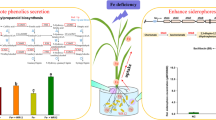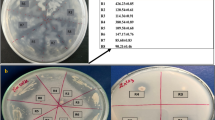Abstract
Background and Aims
Many microbes are beneficial to plants and are termed as plant growth promoting bacteria (PGPB). This study explores the effect and mechanism of endophytic bacteria on wheat iron stress.
Methods
Bacteria and wheat seedlings were hydroponically co-cultured under different concentrations of iron. Growth parameters were measured and transcriptions of ferritins as well as transporters were quantified by real-time quantitative PCR.
Results
An endophytic Bacillus altitudinis WR10 was isolated from the root of Triticum aestivum L. The strain is resistant to 5 mM iron and it bioleaches more than 80% iron after 24 h of incubation. Meanwhile, WR10 produces as much as 35pM indole 3 acetic acid (IAA) during fermentation but there was no accumulation of cytokinin (zeatin to be precise). Inoculation of WR10 significantly improves the growth of the primary root and main sprout in wheat seedlings in a co-culture model under iron stress after two weeks hydroponic cultivation. The presence of WR10 up-regulates the expression of many genes encoding ferritins in wheat roots under iron stress.
Conclusions
Besides its ability to bioleach iron, IAA producing B. altitudinis WR10 can alleviate iron stress in wheat by up-regulation of ferritin-encoded genes in roots, which is important for maintaining iron homeostasis.





Similar content being viewed by others
Explore related subjects
Discover the latest articles and news from researchers in related subjects, suggested using machine learning.Abbreviations
- B. altitudinis :
-
Bacillus altitudinis
- CTKs:
-
Cytokinins
- ELISA:
-
Enzyme Linked Immuno-Sorbent Assay
- IAA:
-
Indole 3 Acetic Acid
- PGPB:
-
Plant Growth Promoting Bacteria
- T. aestivum :
-
Triticum aestivum L.
References
Ali B, Sabri AN, Ljung K, Hasnain S (2009) Auxin production by plant associated bacteria: impact on endogenous IAA content and growth of Triticum aestivum L. Lett Appl Microbiol 48:542–547
Alluri HK, Ronda SR, Settalluri VS, Bondili JS, Suryanarayana V, Venkateshwar P (2007) Biosorption: an eco-friendly alternative for heavy metal removal. Afr J Biotechnol 6(25):2924–2931
Barberon M, Zelazny E, Robert S, Conéjéro G, Curie C, Friml J, Vert G (2011) Monoubiquitin-dependent endocytosis of the IRON-REGULATED TRANSPORTER 1 (IRT1) transporter controls iron uptake in plants. Proc Natl Acad Sci U S A 108(32):E450–E458
Bar-Ness E, Hadar Y, Chen Y, Römheld V, Marschner H (1992) Shorterm effects of rhizosphere microorganisms on Fe uptake from microbial siderophores by maize and oat. Plant Physiol 100:1–56
Becker M, Asch F (2005) Iron toxicity in rice-conditions and management concepts. J Plant Nutr Soil Sci 168:558–573
Briat JF (1996) Roles of ferritin in plants. J Plant Nutr 19:1331–1342
Briat JF, Gaymard F (2007) Iron nutrition and interactions in plants-preface. Plant Physiol Biochem 45:259
Briat JF, Dubos C, Gaymard F (2015) Iron nutrition, biomass production, and plant product quality. Trends Plant Sci 20(1):33–40
Bustin SA, Benes V, Garson JA, Hellemans J, Huggett J, Kubista M, Mueller R, Nolan T, Pfaffl MW, Shipley GL, Vandesompele J, Wittwer CT (2009) The MIQE guidelines: minimum information for publication of quantitative real-time PCR experiments. Clin Chem 55:611–622
Chamam A, Sanguin H, Bellvert F, Meiffren G, Comte G, Wisniewski-Dyé F, Bertrand C, Prigent-Combaret C (2013) Plant secondary metabolite profiling evidences strain-dependent effect in the Azospirillum-Oryza sativa association. Phytochemistry 87:65–77
Combes-Meynet E, Pothier JF, Mënne-Loccoz Y, Prigent-Combaret C (2011) The Pseudomonas secondary metabolite 2,4-diacetylphloroglucinol is a signal inducing rhizoplane expression of Azospirillum genes involved in plant-growth promotion. Mol Plant-Microbe Interact 24:271–284
Compant S, Clément C, Sessitsch A (2010) Plant growth-promoting bacteria in the rhizo- and endosphere of plants: their role, colonization, mechanisms involved and prospects for utilization. Soil Biol Biochem 42:669–678
Contesto C, Milesi S, Mantelin S, Zancarini A, Desbrosses G, Varoquaux F, Bellini C, Kowalczyk M, Touraine B (2010) The auxin-signaling pathway is required for the lateral root response of Arabidopsis to the rhizobacterium Phyllobacterium brassicacearum. Planta 232:1455–1470
Couillerot O, Prigent-Combaret C, Caballero-Mellado J, Mënne-Loccoz Y (2009) Pseudomonas fluorescens And closely-related fluorescent pseudomonads as biocontrol agents of soil-borne phytopathogens. Lett Appl Microbiol 48:505–512
Da Mota FF, Gomes EA, Seldin L (2008) Auxin production and detection of the gene coding for the auxin efflux carrier (AEC) protein in Paenibacillus polymyxa. J Microbiol 46(3):257–264
Dawson MV, Lyle SJ (1990) Spectrophotometric determination of iron and cobalt with Ferrozine and dithizone. Talanta 37(12):1189–1191
Dobbelaere S, Croonenborghs A, Thys A, Vande Broek A, Vanderleyden J (1999) Phytostimulatory effect of Azospirillum brasilense wild type and mutant strains altered in IAA production on wheat. Plant Soil 212:153–162
de Dorlodot S, Lutts S, Bertin P (2005) Effects of ferrous iron toxicity on the growth and mineral composition of an inter specific rice. J Plant Nutr 28:1–20
El Zemrany H, Czarnes S, Hallett PD, Alamercery S, Bally R, Jocteur-Monrozier L (2007) Early changes in root characteristics of maize (Zea mays) following seed inoculation with the PGPR Azospirillum lipoferum CRT1. Plant Soil 291:109–118
Finatto T, de Oliveira AC, Chaparro C, da Maia LC, Farias DR, Woyann LG, Mistura CC, Soares-Bresolin AP, Llauro C, Panaud O, Picault N (2015) Abiotic stress and genome dynamics: specific genes and transposable elements response to iron excess in rice. Rice (N Y) 8:13
Fofana AA (2009) Rice yiel gap due to iron toxicity in West Africa. J Agron Crop Sci 195:66–76
Franken P (2012) The plant strengthening root endophyte Piriformospora indica: potential application and the biology behind. Appl Microbiol Biotechnol 96(6):1455–1464
Freitas MA, Medeiros FH, Carvalho SP, Guilherme LR, Teixeira WD, Zhang H, Paré PW (2015) Augmenting iron accumulation in cassava by the beneficial soil bacterium Bacillus subtilis (GB03). Front Plant Sci 6:596
Guo JH, Liu XJ, Zhang Y, Shen JL, Han WX, Zhang WF, Christie P, Goulding KW, Vitousek PM, Zhang FS (2010) Significant acidification in major Chinese croplands. Science 327(5968):1008–1010
Hall TA (1999) BioEdit: a user-friendly biological sequence alignment editor and analysis program for windows 95/98/NT. Nucleic Acids Symp Ser 41:95–98
Huang B, Johnson JW, NeSmith DS, Bridges DC (1995) Nutrient accumulation and distribution of wheat genotypes in response to waterlogging and nutrient supply. Plant Soil 173:47–54
Hussain A, Hasnain S (2009) Cytokinin production by some bacteria: its impact on cell division in cucumber cotyledons. Afr J Microbiol Res 3:704–712
Jing YD, He ZL, Yang XE (2007) Role of soil rhizobacteria in phytoremediation of heavy metal contaminated soils. J Zhejiang Univ Sci B 8:192–207
Johnson CN, Fisher PR, Huang JS, Vetanovetz RP, Argo WR (2010) Quantifying the acidity of an ammonium-based fertilizer in containerized plant production. Hortscience 45(7):1099–1105
Joshi JG, Sczekan SR, Fleming JT (1989) Ferritin-a general metal detoxicant. Biol Trace Elem Res 21:105–110
Khabaz-Saberi H, Setter TL, Waters I (2006) Waterlogging induces high to toxic concentrations of iron, aluminium and manganese in wheat varieties on acidic soil. J Plant Nutr 29:899–912
Khabaz-Saberi H, Rengel Z, Wilson R, Setter TL (2010) Variation for tolerance to high concentration of ferrous iron (Fe2+) in Australian hexaploid wheat. Euphytica 172:275–283
Khabaz-Saberi H, Barker SJ, Rengel Z (2012) Tolerance to iron toxicities enhances wheat (Triticum aestivum L.) grain yield in waterlogged acidic soils. Plant Soil 354:371–381
Kim SA, Guerinot ML (2007) Mining iron: iron uptake and transport in plants. FEBS Lett 581(12):2273–2280
Kim SU, Cheong YH, Seo DC, Hur JS, Heo JS, Cho JS (2007) Characterisation of heavy metal tolerance and biosorption capacity of bacterium strain CPB4 (Bacillus spp.) Water Sci Technol J Int Asso Water Pollut Res 55:105–111
Li X, Ma H, Jia P, Wang J, Jia L, Zhang T, Yang Y, Chen H, Wei X (2012) Responses of seedling growth and antioxidant activity to excess iron and copper in Triticum aestivum L. Ecotoxicol Environ Saf 86:47–53
Lin W, Okon Y, Hardy RWF (1983) Enhanced mineral uptake by Zea mays and Sorghum bicolor roots inoculated with Azospirillum brasilense. Appl Environ Microbiol 45:1775–1779
Liu F, Xing S, Ma H, Du Z, Ma B (2013) Cytokinin-producing, plant growth-promoting rhizobacteria that confer resistance to drought stress in Platycladus orientalis container seedlings. Appl Microbiol Biotechnol 97(20):9155–9164
Lugtenberg BJ, Kamilova F (2009) Plant-growth-promoting rhizobacteria. Annu Rev Microbiol 63:541–556
Nagajyoti PC, Lee KD, Sreekanth TVM (2010) Heavy metals, occurrence and toxicity for plants: a review. Environ Chem Lett 8:199–216
Orhan F (2016) Alleviation of salt stress by halotolerant and halophilic plant growth-promoting bacteria in wheat (Triticum aestivum). Braz J Microbiol 47(3):621–627
Patten CL, Glick BR (2002) Role of Pseudomonas putida indole acetic acid in development of the host plant root system. Appl Environ Microbiol 68:3795–3801
Pereira SI, Castro PM (2014) Diversity and characterization of culturable bacterial endophytes from Zea mays and their potential as plant growth-promoting agents in metal-degraded soils. Environ Sci Pollut Res Int 21(24):14110–14123
Pereira MP, Santos C, Gomes A, Vasconcelos MW (2014) Cultivar variability of iron uptake mechanisms in rice (Oryza sativa L.) Plant Physiol Biochem 85:21–30
Remans R, Beebe S, Blair M, Manrique G, Tovar E, Rao IM (2008) Physiological and genetic analysis of root responsiveness to auxin-producing plant growth-promoting bacteria in common bean (Phaseolus vulgaris L.) Plant Soil 302:149–161
Richardson AE, Baréa JM, McNeill AM, Prigent-Combaret C (2009) Acquisition of phosphorus and nitrogen in the rhizosphere and plant growth promotion by microorganisms. Plant Soil 321:305–339
Sahrawat KL (2004) Iron toxicity in wetland rice and the role of other nutrients. J Plant Nutr 27(8):1471–1504
Schützendübel A, Polle A (2002) Plant responses to abiotic stresses: heavy metal-induced oxidative stress and protection by mycorrhization. J Exp Bot 53(372):1351–1365
Setter TL, Waters I, Sharma SK, Singh KN, Kulshreshtha N, Yaduvanshi NP, Ram PC, Singh BN, Rane J, McDonald G, Khabaz-Saberi H, Biddulph TB, Wilson R, Barclay I, McLean R, Cakir M (2009) Review of wheat improvement for waterlogging tolerance in Australia and India: the importance of anaerobiosis and element toxicities associated with different soils. Ann Bot 103(2):221–235
Shukla KP, Sharma S, Singh NK, Singh V, Tiwari K, Singh S (2011) Nature and role of root exudates: efficacy in bioremediation. Afr J Biotechnol 10:9717–9724
Sinha S, Guptha M, Chandra P (1997) Oxidative stress induced by iron in Hydrilla verticillata (i.f) Royle: response of antioxidants. Ecotoxicol Environ Safe 38:286–291
Speakman JB, Krüger W (1983) A comparison of methods to surface sterilize wheat seeds. Trans Br Mycol Soc 80(2):374–376
Theil EC, Tosha T, Behera RK (2016) Solving biology's iron chemistry problem with ferritin protein nanocages. Acc Chem Res 49(5):784–791
Uauy C, Distelfeld A, Fahima T, Blechl A, Dubcovsky J (2006) A NAC gene regulating senescence improves grain protein, zinc, and iron content in wheat. Science 314:1298–1301
Vacheron J, Desbrosses G, Bouffaud ML, Touraine B, Moënne-Loccoz Y, Muller D, Legendre L, Wisniewski-Dyé F, Prigent-Combaret C (2013) Plant growth-promoting rhizobacteria and root system functioning. Front Plant Sci 4:356
Veresoglou SD, Menexes G (2010) Impact of inoculation with Azospirillum spp. on growth properties and seed yield of wheat: a meta-analysis of studies in the ISI web of science from 1981 to 2008. Plant Soil 337:469–480
Verma P, Yadav AN, Khannam KS, Kumar S, Saxena AK, Suman A (2016) Molecular diversity and multifarious plant growth promoting attributes of bacilli associated with wheat (Triticum aestivum L.) rhizosphere from six diverse agro-ecological zones of India. J Basic Microbiol 56(1):44–58
Walker V, Couillerot O, Von Felten A, Bellvert F, Jansa J, Maurhofer M, Bally R, Moënne-Loccoz Y, Comte G (2012) Variation of secondary metabolite levels in maize seedling roots induced by inoculation with Azospirillum, Pseudomonas and Glomus consortium under field conditions. Plant Soil 356:151–163
Waters BM, Uauy C, Dubcovsky J, Grusak MA (2009) Wheat (Triticum aestivum) NAM proteins regulate the translocation of iron, zinc, and nitrogen compounds from vegetative tissues to grain. J Exp Bot 60(15):4263–4274
Wen YM, Cheng Y, Tang C, Chen ZL (2013) Bioleaching of heavy metals from sewage sludge using indigenous iron-oxidizing microorganisms. J Soil Sed 13:166–175
Zhang Z, Schwartz S, Wagner L, Miller W (2000) A greedy algorithm for aligning DNA sequences. J Comput Biol 7(1–2):203–214
Zhang H, Kim MS, Krishnamachari V, Payton P, Sun Y, Grimson M, Farag MA, Ryu CM, Allen R, Melo IS, Paré PW (2007) Rhizobacterial volatile emissions regulate auxin homeostasis and cell expansion in Arabidopsis. Planta 226:839–851
Zhuang XL, Chen J, Shim H, Bai Z (2007) New advances in plant growth-promoting rhizobacteria for bioremediation. Environ Int 33:406–413
Zuo Y, Zhang F (2011) Soil and crop management strategies to prevent iron deficiency in crops. Plant Soil 339(339):83–95
Acknowledgements
We acknowledge Dr. Hongzhan Liu from Zhoukou Normal University for sharing both seeds and Triticum aestivum L. zhoumai 26 seedlings. This study was partially funded by the Plan For Scientific Innovation Talent of Henan Province (No. 124100510021) to C. Li. Z. Sun received an international cooperation grant from Henan Province Science and Technology Agency (No. 172102410055). K. Liu received a grant from the key scientific and technological project of Henan province (No. 152102410074). The funders had no role in study design, data collection and analysis, decision to publish, or preparation of the manuscript. The authors declare that they have no conflict of interest.
Author information
Authors and Affiliations
Corresponding author
Additional information
Responsible Editor: Stéphane Compant.
Electronic supplementary material
ESM 1
(DOCX 1355 kb)
Rights and permissions
About this article
Cite this article
Sun, Z., Liu, K., Zhang, J. et al. IAA producing Bacillus altitudinis alleviates iron stress in Triticum aestivum L. seedling by both bioleaching of iron and up-regulation of genes encoding ferritins. Plant Soil 419, 1–11 (2017). https://doi.org/10.1007/s11104-017-3218-9
Received:
Accepted:
Published:
Issue Date:
DOI: https://doi.org/10.1007/s11104-017-3218-9
Keywords
Profiles
- Zhongke Sun View author profile




